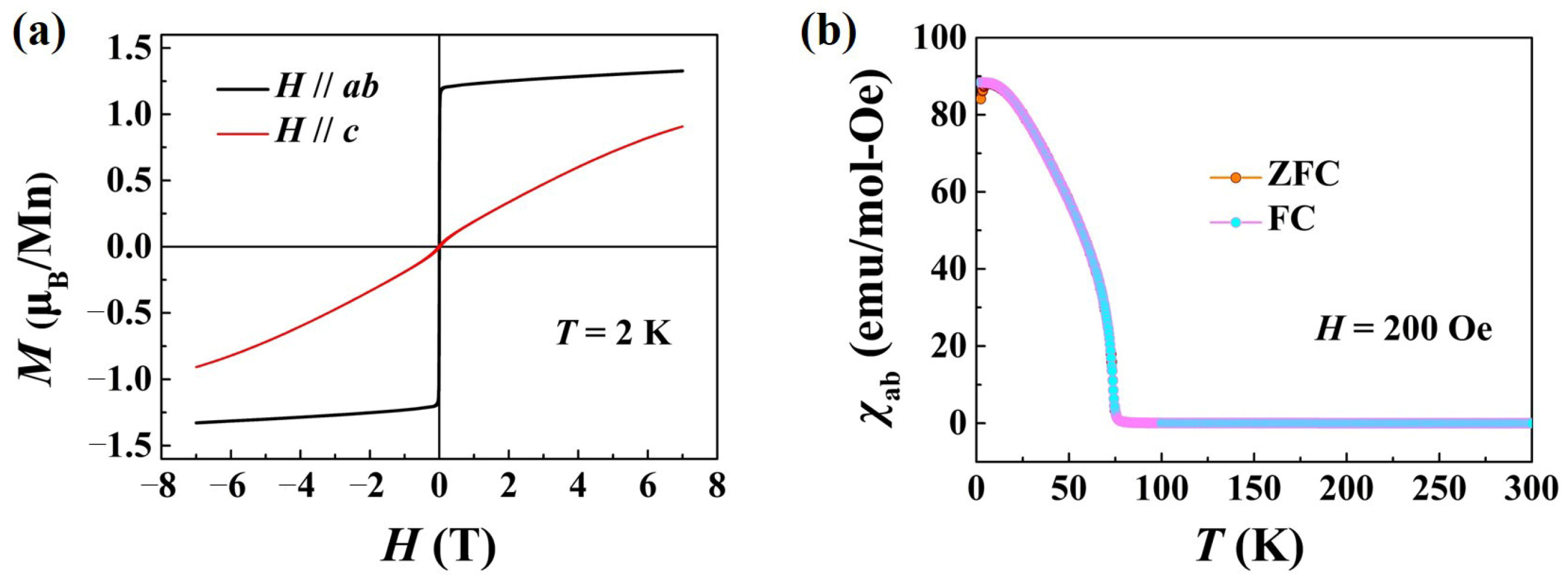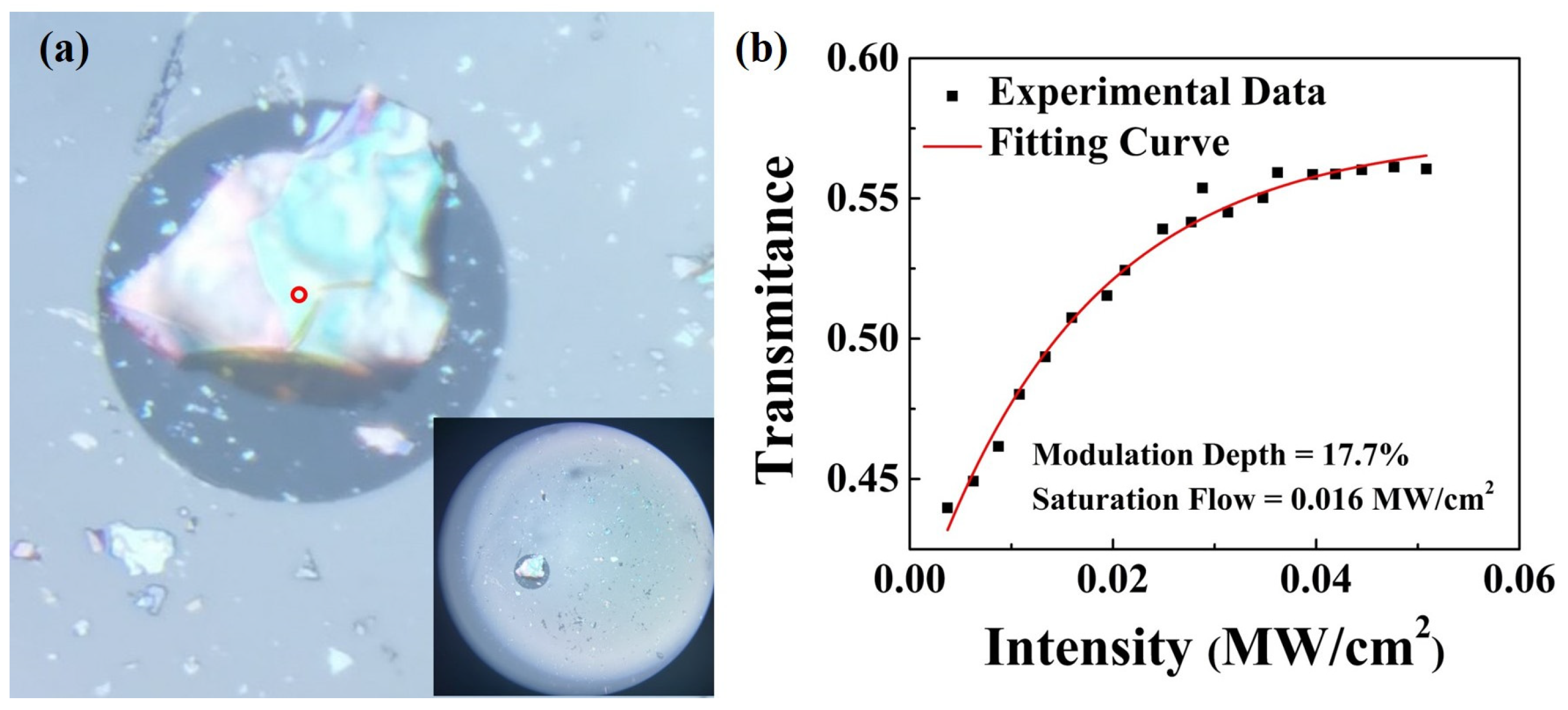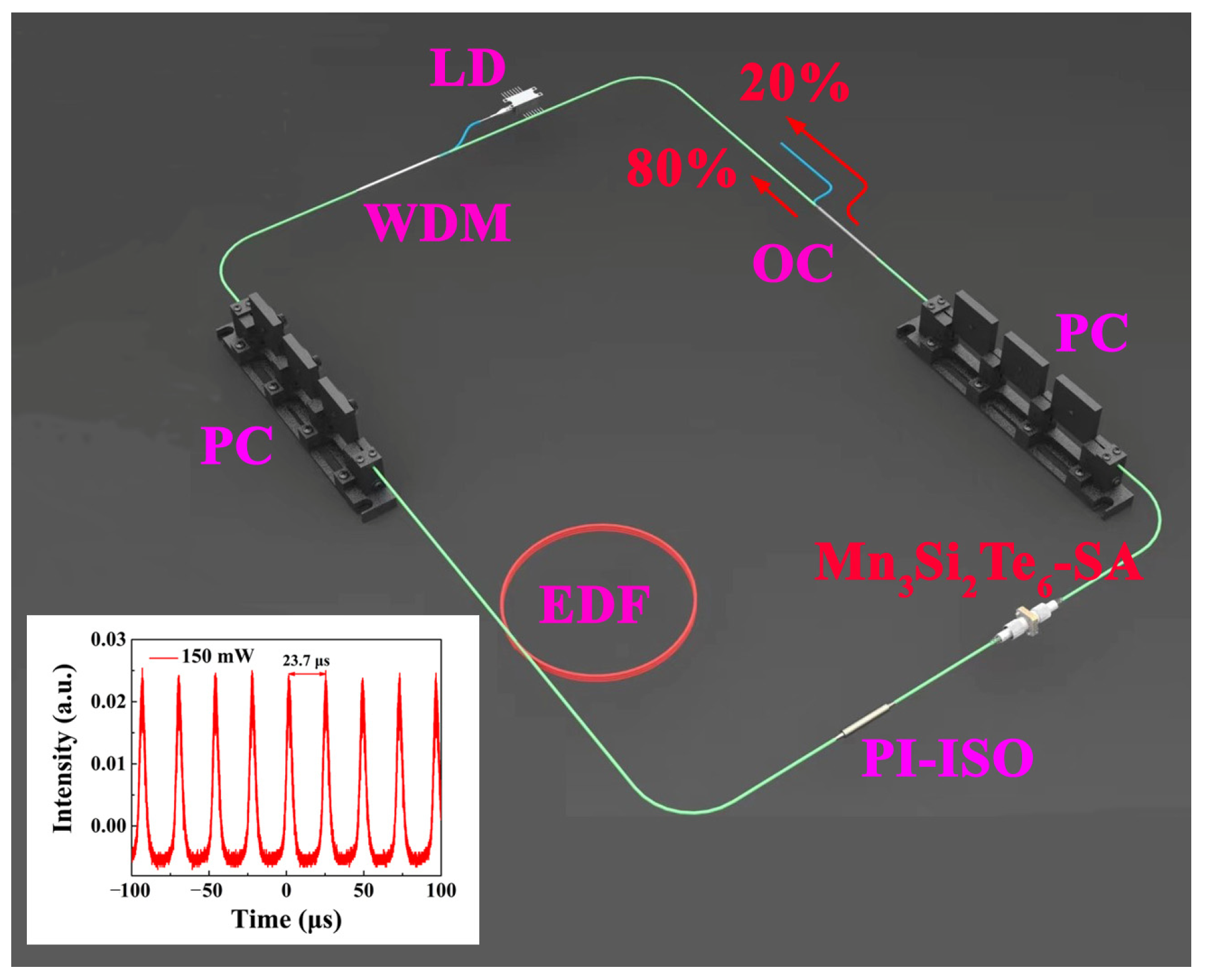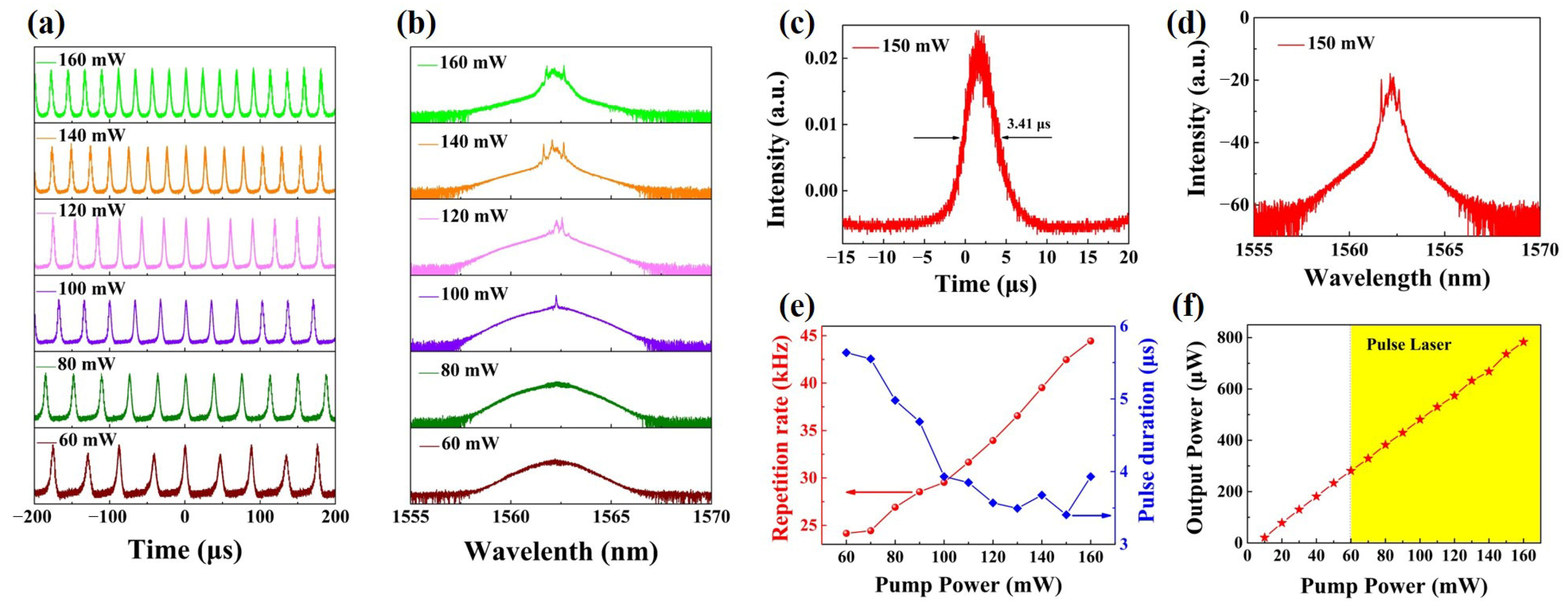Quasi-2D Mn3Si2Te6 Nanosheet for Ultrafast Photonics
Abstract
:1. Introduction
2. Fabrication and Characterization of Mn3Si2Te6
2.1. Crystal Growth
2.2. Apparatus and Characterization
3. Generation of the Short Fiber Pulsed Laser
4. Conclusions
Author Contributions
Funding
Data Availability Statement
Conflicts of Interest
References
- Philippov, V.; Codemard, C.; Jeong, Y.; Alegria, C.; Sahu, J.K.; Nilsson, J.; Pearson, G.N. High-energy in-fiber pulse amplification for coherent lidar applications. Opt. Lett. 2004, 29, 2590–2592. [Google Scholar] [CrossRef] [PubMed]
- Diaz, S.; Leandro, D.; Lopez-Amo, M. Stable multiwavelength erbium fiber ring laser with optical feedback for remote sensing. J. Light. Technol. 2015, 33, 2439–2444. [Google Scholar] [CrossRef]
- Gopinath, J.T.; Shen, H.M.; Sotobayashi, H.; Ippen, E.P.; Hasegawa, T.; Nagashima, T.; Sugimoto, N. Highly nonlinear bismuth-oxide fiber for smooth supercontinuum generation at 1.5 µm. Opt. Express 2004, 12, 5697–5702. [Google Scholar] [CrossRef]
- Doruk, E.; Slava, L.; Frank, K.; Kent, P.; Xung, D.; Jean-Luc, F.; Nigel, M.; Mark, S.; Shantanu, G.; Rich, U. Highly reliable and efficient 1.5um-fiber-MOPA-based, high-power laser transmitter for space communication. In Proceedings of the Laser Technology for Defense and Security X, SPIE, Baltimore, MD, USA, 5–9 June 2014; p. 90810G. [Google Scholar]
- Liu, Y.; Gassino, R.; Braglia, A.; Vallan, A.; Perrone, G. Fibre probe for tumour laser thermotherapy with integrated temperature measuring capabilities. Electron. Lett. 2016, 52, 798–800. [Google Scholar] [CrossRef]
- Liu, S.; Huang, H.; Lu, J.; Xu, N.; Qu, J.; Wen, Q. Liquid-Phase Exfoliation of Ta2NiS5 and Its Application in Near-Infrared Mode-Locked Fiber Lasers with Evanescent Field Interactions and Passively Q-Switched Bulk Laser. Nanomaterials 2022, 12, 695. [Google Scholar] [CrossRef]
- Lin, H.; Bao, S.; Liu, X.; Song, S.; Wen, Z.; Sun, D. Dual-Wavelength Continuous-Wave and Passively Q-Switched Alexandrite Laser at 736.7 nm and 752.8 nm. Photonics 2022, 9, 769. [Google Scholar] [CrossRef]
- Guo, X.; Wang, S.; Yan, P.; Wang, J.; Yu, L.; Liu, W.; Zheng, Z.; Guo, C.; Ruan, S. High Modulation Depth Enabled by Mo2Ti2C3Tx MXene for Q-Switched Pulse Generation in a Mid-Infrared Fiber Laser. Nanomaterials 2022, 12, 1343. [Google Scholar] [CrossRef]
- Yang, Z.; Zaheer Ud Din, S.; Wang, P.; Li, C.; Lin, Z.; Leng, J.; Liu, J.; Xu, L.; Yang, Q.; Ren, X. Blue LD-pumped electro-optically Q-switched Pr:YLF visible laser with kilowatt-level peak power. Opt. Laser Technol. 2022, 148, 107711. [Google Scholar] [CrossRef]
- Ahmad, H.; Reduan, S.A. Passively Q-switched S-band thulium fluoride fiberlaser with multi-walled carbon nanotube. Chin. Opt. Lett. 2018, 16, 010609. [Google Scholar] [CrossRef]
- Meng, Y.; Liu, Y.; Li, T.; Feng, T.; Huang, J.; Ni, Z.; Qiao, W. Investigation of Nonlinear Optical Modulation Characteristics of MXene VCrC for Pulsed Lasers. Molecules 2022, 27, 759. [Google Scholar] [CrossRef]
- Degnan, J.J. Optimization of passively Q-switched lasers. IEEE J. Quantum Electron. 1995, 31, 1890–1901. [Google Scholar] [CrossRef]
- Yumashev, K.V.; Denisov, I.A.; Posnov, N.N.; Kuleshov, N.V.; Moncorge, R. Excited state absorption and passive Q-switch performance of Co2+ doped oxide crystals. J. Alloys Compd. 2002, 341, 366–370. [Google Scholar] [CrossRef]
- Bai, Y.; Wu, N.; Zhang, J.; Li, J.; Li, S.; Xu, J.; Deng, P. Passively Q-switched Nd:YVO4 laser with a Cr4+:YAG crystal saturable absorber. Appl. Opt. 1997, 36, 2468–2472. [Google Scholar] [CrossRef] [PubMed]
- Tang, C.Y.; Cheng, P.K.; Tao, L.; Long, H.; Zeng, L.H.; Wen, Q.; Tsang, Y.H. Passively Q-Switched Nd:YVO4 Laser Using WS2 Saturable Absorber Fabricated by Radio Frequency Magnetron Sputtering Deposition. J. Light. Technol. 2017, 35, 4120–4124. [Google Scholar] [CrossRef]
- Kang, Z.; Liu, M.; Li, Z.; Li, S.; Jia, Z.; Liu, C.; Qin, W.; Qin, G. Passively Q-switched erbium doped fiber laser using a gold nanostars based saturable absorber. Photonics Res. 2018, 6, 549–553. [Google Scholar] [CrossRef]
- Wang, X.-D.; Luo, Z.-C.; Liu, H.; Zhao, N.; Liu, M.; Zhu, Y.-F.; Xue, J.-P.; Luo, A.-P.; Xu, W.-C. Gold nanorod as saturable absorber for Q-switched Yb-doped fiber laser. Opt. Commun. 2015, 346, 21–25. [Google Scholar] [CrossRef]
- Zhou, W.; Pang, X.; Zhang, H.; Yu, Q.; Liu, F.; Wang, W.; Zhao, Y.; Lu, Y.; Yang, Z. Frontier and Hot Topics of Pulsed Fiber Lasers via CiteSpace Scientometric Analysis: Passively Mode-Locked Fiber Lasers with Real Saturable Absorbers Based on Two-Dimensional Materials. Materials 2022, 15, 6761. [Google Scholar] [CrossRef]
- Bao, Q.; Zhang, H.; Wang, Y.; Ni, Z.; Yan, Y.; Shen, Z.X.; Loh, K.P.; Tang, D.Y. Atomic-Layer Graphene as a Saturable Absorber for Ultrafast Pulsed Lasers. Adv. Funct. Mater. 2009, 19, 3077–3083. [Google Scholar] [CrossRef]
- Wang, J.; Wang, Y.; Wang, T.; Li, G.; Lou, R.; Cheng, G.; Bai, J. Nonlinear Optical Response of Graphene Oxide Langmuir-Blodgett Film as Saturable Absorbers. Nanomaterials 2019, 9, 640. [Google Scholar] [CrossRef]
- Zhang, H.; Lu, S.B.; Zheng, J.; Du, J.; Wen, S.C.; Tang, D.Y.; Loh, K.P. Molybdenum disulfide (MoS2) as a broadband saturable absorber for ultra-fast photonics. Opt. Express 2014, 22, 7249–7260. [Google Scholar] [CrossRef]
- Wang, K.; Wang, J.; Fan, J.; Lotya, M.; O’Neill, A.; Fox, D.; Feng, Y.; Zhang, X.; Jiang, B.; Zhao, Q.; et al. Ultrafast Saturable Absorption of Two-Dimensional MoS2 Nanosheets. ACS Nano 2013, 7, 9260–9267. [Google Scholar] [CrossRef]
- Zhao, C.; Zhang, H.; Qi, X.; Chen, Y.; Wang, Z.; Wen, S.; Tang, D. Ultra-short pulse generation by a topological insulator based saturable absorber. Appl. Phys. Lett. 2012, 101, 211106. [Google Scholar] [CrossRef]
- Wang, T.; Zhang, W.; Wang, J.; Wu, J.; Hou, T.; Ma, P.; Su, R.; Ma, Y.; Peng, J.; Zhan, L.; et al. Bright/dark switchable mode-locked fiber laser based on black phosphorus. Opt. Laser Technol. 2020, 123, 105948. [Google Scholar] [CrossRef]
- Chen, Y.; Jiang, G.; Chen, S.; Guo, Z.; Yu, X.; Zhao, C.; Zhang, H.; Bao, Q.; Wen, S.; Tang, D.; et al. Mechanically exfoliated black phosphorus as a new saturable absorber for both Q-switching and Mode-locking laser operation. Opt. Express 2015, 23, 12823–12833. [Google Scholar] [CrossRef] [PubMed]
- Wang, T.; Jin, X.; Yang, J.; Wu, J.; Yu, Q.; Pan, Z.; Shi, X.; Xu, Y.; Wu, H.; Wang, J.; et al. Oxidation-Resistant Black Phosphorus Enable Highly Ambient-Stable Ultrafast Pulse Generation at a 2 mum Tm/Ho-Doped Fiber Laser. ACS Appl. Mater. Interfaces 2019, 11, 36854–36862. [Google Scholar] [CrossRef]
- Jhon, Y.I.; Koo, J.; Anasori, B.; Seo, M.; Lee, J.H.; Gogotsi, Y.; Jhon, Y.M. Metallic MXene Saturable Absorber for Femtosecond Mode-Locked Lasers. Adv. Mater. 2017, 29, 1702496. [Google Scholar] [CrossRef]
- Yang, Z.; Yang, Q.; Tian, Y.; Ren, X.; Li, C.; Zu, Y.; Zaheer Ud Din, S.; Gao, L.; Wu, J.; Chen, H.; et al. Few-layer Ti3CN MXene for ultrafast photonics applications in visible band. J. Mater. 2022, 9, 44–45. [Google Scholar] [CrossRef]
- Zhang, Z.; Lin, P.; Liao, Q.; Kang, Z.; Si, H.; Zhang, Y. Graphene-Based Mixed-Dimensional van der Waals Heterostructures for Advanced Optoelectronics. Adv. Mater. 2019, 31, e1806411. [Google Scholar] [CrossRef]
- Luo, Z.; Zhou, M.; Weng, J.; Huang, G.; Xu, H.; Ye, C.; Cai, Z. Graphene-based passively Q-switched dual-wavelength erbium-doped fiber laser. Opt. Lett. 2010, 35, 3709–3711. [Google Scholar] [CrossRef]
- Jung, M.; Lee, J.; Koo, J.; Park, J.; Song, Y.-W.; Lee, K.; Lee, S.; Lee, J.H. A femtosecond pulse fiber laser at 1935 nm using a bulk-structured Bi2Te3 topological insulator. Opt. Express 2014, 22, 7865–7874. [Google Scholar] [CrossRef]
- Shi, X.; Wang, T.; Wang, J.; Xu, Y.; Yang, Z.; Yu, Q.; Wu, J.; Zhang, K.; Zhou, P. Synthesis of black arsenic-phosphorus and its application for Er-doped fiber ultrashort laser generation. Opt. Mater. Express 2019, 9, 2348–2357. [Google Scholar] [CrossRef]
- Deng, H.; Xu, X.; Liu, F.; Yu, Q.; Shu, B.; Yang, Z.; Zhu, S.; Zhang, Q.; Wu, J.; Zhou, P. Mode-locking Pulse Generation Based on Lead-free Halide Perovskite CsCu2I3 Micro-rods with High Stability. J. Mater. Chem. C, 2023; Advance Article. [Google Scholar] [CrossRef]
- Guo, K.; Fan, C.; Yu, Q.; Wang, J.; Deng, H.; Wang, T.; Liu, F.; Ding, X.; Pan, Z.; Zhu, S.; et al. Time-domain flexible pulse fiber laser generation and high-power evolution based on inter-band excitation of lead sulfide nanoflakes. Opt. Commun. 2023, 529, 129065. [Google Scholar] [CrossRef]
- Kobtsev, S.M. Artificial saturable absorbers for ultrafast fibre lasers. Opt. Fiber Technol. 2022, 68, 102764. [Google Scholar] [CrossRef]
- Cai, K.; Zhang, X.; Wang, X.; Tong, C.; Wang, L. Broadband Tunable Passively Q-Switched Erbium-Doped ZBLAN Fiber Laser Using Fe3O4-Nanoparticle Saturable Absorber. Appl. Sci. 2022, 12, 9168. [Google Scholar] [CrossRef]
- Mohammed, D.Z.; Khaleel, W.A.; Al-Janabi, A.H. Tunable Q-switched erbium doped fiber laser based on metal transition oxide saturable absorber and refractive index characteristic of multimode interference effects. Opt. Laser Technol. 2017, 97, 106–110. [Google Scholar] [CrossRef]
- Bai, X.; Mou, C.; Xu, L.; Wang, S.; Pu, S.; Zeng, X. Passively Q-switched erbium-doped fiber laser using Fe3O4-nanoparticle saturable absorber. Appl. Phys. Express 2016, 9, 042701. [Google Scholar] [CrossRef]
- Mao, D.; Cui, X.; He, Z.; Lu, H.; Zhang, W.; Wang, L.; Zhuang, Q.; Hua, S.; Mei, T.; Zhao, J. Broadband polarization-insensitive saturable absorption of Fe2O3 nanoparticles. Nanoscale 2018, 10, 21219–21224. [Google Scholar] [CrossRef]
- Zhang, Y.; Ni, Y.; Zhao, H.; Hakani, S.; Ye, F.; DeLong, L.; Kimchi, I.; Cao, G. Control of chiral orbital currents in a colossal magnetoresistance material. Nature 2022, 611, 467–472. [Google Scholar] [CrossRef] [PubMed]
- Sala, G.; Lin, J.Y.Y.; Samarakoon, A.M.; Parker, D.S.; May, A.F.; Stone, M.B. Ferrimagnetic spin waves in honeycomb and triangular layers of Mn3Si2Te6. Phys. Rev. B 2022, 105, 214405. [Google Scholar] [CrossRef]
- May, A.F.; Liu, Y.; Calder, S.; Parker, D.S.; Pandey, T.; Cakmak, E.; Cao, H.; Yan, J.; McGuire, M.A. Magnetic order and interactions in ferrimagnetic Mn3Si2Te6. Phys. Rev. B 2017, 95, 174440. [Google Scholar] [CrossRef]
- Vincent, H.; Leroux, D.; Bijaoui, D.; Rimet, R.; Schlenker, C. Crystal structure of Mn3Si2Te6. J. Solid State Chem. 1986, 63, 349–352. [Google Scholar] [CrossRef]
- Wang, J.; Wang, S.; He, X.; Zhou, Y.; An, C.; Zhang, M.; Zhou, Y.; Han, Y.; Chen, X.; Zhou, J.; et al. Pressure engineering of colossal magnetoresistance in the ferrimagnetic nodal-line semiconductor Mn3Si2Te6. Phys. Rev. B 2022, 106, 045106. [Google Scholar] [CrossRef]
- Liu, Y.; Hu, Z.; Abeykoon, M.; Stavitski, E.; Attenkofer, K.; Bauer, E.D.; Petrovic, C. Polaronic transport and thermoelectricity in Mn3Si2Te6 single crystals. Phys. Rev. B 2021, 103, 245122. [Google Scholar] [CrossRef]
- Rimet, R.; Schlenker, C.; Vincent, H. A new semiconducting ferrimagnet: A silicon manganese telluride. J. Magn. Magn. Mater. 1981, 25, 7–10. [Google Scholar] [CrossRef]
- Jiang, K.; Ji, J.; Gong, W.; Ding, L.; Li, J.; Li, P.; Li, B.; Geng, F. Mechanical cleavage of non-van der Waals structures towards two-dimensional crystals. Nat. Synth. 2023, 2, 58–66. [Google Scholar] [CrossRef]
- Wang, T.; Yu, Q.; Guo, K.; Shi, X.; Kan, X.; Xu, Y.; Wu, J.; Zhang, K.; Zhou, P. Sb2Te3 topological insulator for 52 nm wideband tunable Yb-doped passively Q-switched fiber laser. Front. Inf. Technol. Electron. Eng. 2021, 22, 287–295. [Google Scholar] [CrossRef]
- Chen, Y.; Zhao, C.; Huang, H.; Chen, S.; Tang, P.; Wang, Z.; Lu, S.; Zhang, H.; Wen, S.; Tang, D. Self-Assembled Topological Insulator: Bi2Se3 Membrane as a Passive Q-Switcher in an Erbium-Doped Fiber Laser. J. Light. Technol. 2013, 31, 2857–2863. [Google Scholar] [CrossRef]





| Materials | Gain Medium | Wavelength | Pulse Width | Repetition Rate | Pulse Energy | Pump Power | Output Power | Ref. |
|---|---|---|---|---|---|---|---|---|
| Graphene | Er-doped | 1566.17 nm; 1566.35 nm | 3.7 μs | 65.9 kHz | 16.7 nJ | 6.5-82.8 mW | 1.1 mW | [30] |
| BP | Er-doped | 1562.87 nm | 10.32 μs | 15.78 kHz | 94.3 nJ | 50-195 mW | ~1.5 mW | [25] |
| b-AsP | Er-doped | 1559.9 nm; 1560.3 nm | 5.26 μs | 38.47 kHz | 96.4 nJ | 20-40 mW | 3.68 mW | [32] |
| Bi2Se3 TI | Er-doped | 1565.14 nm | 13.4 μs | 12.88 kHz | 15 nJ | 41.3-84.3 mW | ~145 μW | [49] |
| Fe3O4 nanoparticles | Er-doped | 1562.4 nm | 2.7 μs | 80 kHz | 78.2 nJ | 80-342 mW | 6.23 mW | [37] |
| Mn3Si2Te6 | Er-doped | 1562 nm | 3.41 μs | 44.44 kHz | - | 60-160 mW | 783 μW | This work |
Disclaimer/Publisher’s Note: The statements, opinions and data contained in all publications are solely those of the individual author(s) and contributor(s) and not of MDPI and/or the editor(s). MDPI and/or the editor(s) disclaim responsibility for any injury to people or property resulting from any ideas, methods, instructions or products referred to in the content. |
© 2023 by the authors. Licensee MDPI, Basel, Switzerland. This article is an open access article distributed under the terms and conditions of the Creative Commons Attribution (CC BY) license (https://creativecommons.org/licenses/by/4.0/).
Share and Cite
Lu, Y.; Zhou, Z.; Kan, X.; Yang, Z.; Deng, H.; Liu, B.; Wang, T.; Liu, F.; Liu, X.; Zhu, S.; et al. Quasi-2D Mn3Si2Te6 Nanosheet for Ultrafast Photonics. Nanomaterials 2023, 13, 602. https://doi.org/10.3390/nano13030602
Lu Y, Zhou Z, Kan X, Yang Z, Deng H, Liu B, Wang T, Liu F, Liu X, Zhu S, et al. Quasi-2D Mn3Si2Te6 Nanosheet for Ultrafast Photonics. Nanomaterials. 2023; 13(3):602. https://doi.org/10.3390/nano13030602
Chicago/Turabian StyleLu, Yan, Zheng Zhou, Xuefen Kan, Zixin Yang, Haiqin Deng, Bin Liu, Tongtong Wang, Fangqi Liu, Xueyu Liu, Sicong Zhu, and et al. 2023. "Quasi-2D Mn3Si2Te6 Nanosheet for Ultrafast Photonics" Nanomaterials 13, no. 3: 602. https://doi.org/10.3390/nano13030602
APA StyleLu, Y., Zhou, Z., Kan, X., Yang, Z., Deng, H., Liu, B., Wang, T., Liu, F., Liu, X., Zhu, S., Yu, Q., & Wu, J. (2023). Quasi-2D Mn3Si2Te6 Nanosheet for Ultrafast Photonics. Nanomaterials, 13(3), 602. https://doi.org/10.3390/nano13030602






